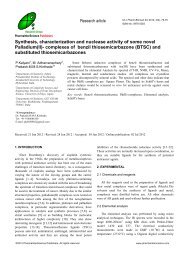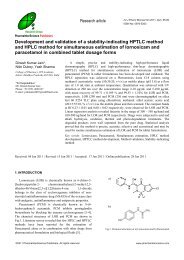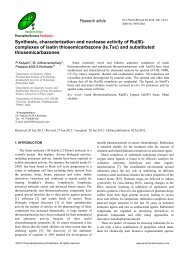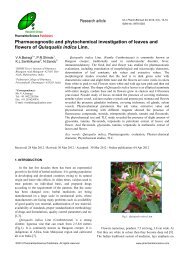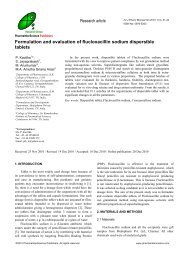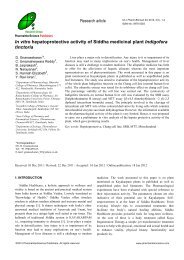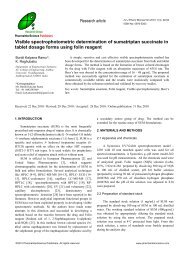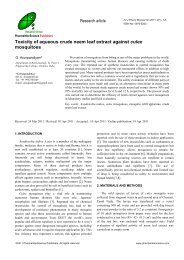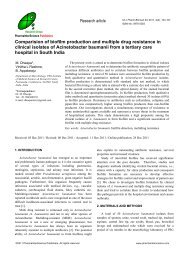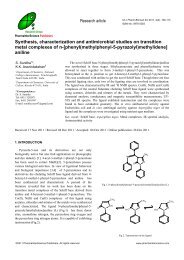A clinical study of vault hematomas after different types of ...
A clinical study of vault hematomas after different types of ...
A clinical study of vault hematomas after different types of ...
You also want an ePaper? Increase the reach of your titles
YUMPU automatically turns print PDFs into web optimized ePapers that Google loves.
Hemant Deshpande et al, Int J Pharm Biomed Sci 2013, 4(3), 91-95<br />
94<br />
hematoma was 19.4%, 70% had small-sized hematoma and<br />
30% had large-sized hematoma. In other studies, incidence <strong>of</strong><br />
postoperative hematoma was detected 25-98% [5,8]. The<br />
incidence <strong>of</strong> <strong>vault</strong> hematoma was found 19.4% in present<br />
<strong>study</strong>. In these patients, 40%(8/20) had fever while only<br />
2.4%(2/83) <strong>of</strong> cases without <strong>vault</strong> hematoma suffered from<br />
fever due to UTI. Study done by Cem Dane et al [17]<br />
indicates out <strong>of</strong> all women having <strong>vault</strong> hematoma,<br />
70%(14/20) had small-sized hematoma and 30% (6/20) had<br />
large-sized hematoma. Fifty percent <strong>of</strong> patients (3/6) with<br />
large-sized hematoma, as compared to only 35%(5/14) with<br />
small-sized hematoma, suffered from febrile morbidity.<br />
Large-sized <strong>hematomas</strong> drained by vaginally, while all smallsized<br />
pelvic <strong>hematomas</strong> managed by watchful expectancy<br />
successfully. The significant difference was found mean<br />
hemoglobin drop and postoperative stay in the hematoma<br />
group or without hematoma group, concluding the<br />
importance <strong>of</strong> sonographic detection <strong>of</strong> vaginal <strong>vault</strong> fluid<br />
collection <strong>after</strong> hysterectomy.<br />
Table 8<br />
Assessment <strong>of</strong> post-operative morbidity parameters in patients with <strong>vault</strong><br />
hematoma<br />
Parameters<br />
Vault hematoma<br />
Present (n=18) Absent (182)<br />
Febrile morbidity 5(27.77%) 1<br />
Drop in hemoglobin 4(5%) 80<br />
Blood transfusion 3(33.33%) 10<br />
Hb drop in g/dL 2.78 averagely 1.24 averagely<br />
Table 9<br />
Relation between size <strong>of</strong> hematoma and post operative morbidity<br />
Small Medium Large<br />
Total no <strong>of</strong> patients 6 7 5<br />
Febrile morbidity 0 3 2<br />
Average Hb drop 1g% 3g% 4g%<br />
Blood transfusion 0 2 1<br />
Mean duration <strong>of</strong> hospital stay 10 days 14 days 20 days<br />
Readmission 0 0 1<br />
Table 10<br />
Relation between suturing technique and <strong>vault</strong> hematoma<br />
Suturing technique Total no <strong>of</strong> cases Hematoma cases (%)<br />
Continuous 100 9(9)<br />
Intermittent 50 1(2)<br />
Continuous locking 50 8(16)<br />
Total 200 18(9)<br />
χ 2 =5.98, P




